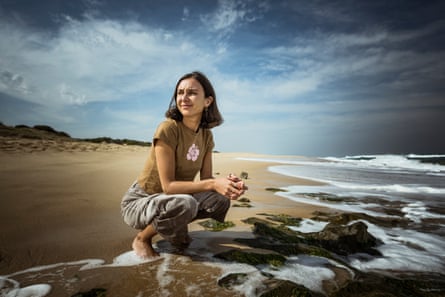[ad_1]
Hannah Lethlean was reading a book at Rye’s ocean beach on a summer Saturday afternoon when she spotted a family getting into trouble in the water. At the same moment, her friend, Wade Cochrane, who was standing in the car park, also noticed the family. The pair raced into the water and dragged ashore the woman and two children.
“We grabbed them by the arms and helped them to shore. And the woman in particular couldn’t even stand,” says Lethlean, from St Andrews Beach on Victoria’s Mornington Peninsula. “It’s possible that if Wade wasn’t there to pull her out that she could have been sucked out again.”
Local residents say scenarios like this are all too common at Victoria’s ocean beaches, which are characterised by big waves, strong rips and unpredictable conditions. There were 24 drownings in the state this summer, four more than the five-year average, and public holidays can be the most dangerous time of all. Life Saving Victoria figures show people in the state are 68% more likely to drown on a public holiday than any other day of the year.
Peninsula residents have had enough of seeing tourists get themselves into trouble.

Prompted in part by the drowning of a young Melbourne man at Gunnamatta beach on 6 January, the residents have been getting proactive to prevent further tragedies.
For Lethlean that means approaching would-be swimmers when conditions look dangerous, while others have distributed surf safety information to local Airbnbs, and surfers are running their own courses in how to conduct rescues.
“Things can spiral pretty quickly,” Lethlean says. “I’ve been in situations before where by the time I see people getting in trouble, it’s pretty clear that it’s way too late to call for help. There’s only a split second … Now I try and be more proactive and at least warn them before they get into the water.”
Somewhat paradoxically, the most treacherous beaches can become the safest spots when surf lifesavers are on duty.
Lifesavers patrol some of the Mornington Peninsula’s busiest back beaches (Gunnamatta, Sorrento and Portsea) each day until about 6pm from the end of December until the end of February, when their watch shifts to weekends and public holidays. Beaches won’t be patrolled during weekdays these Easter holidays and after Anzac Day – they pack up until the following summer.
Often, when lifesavers aren’t there, local surfers are.
“Board riders are frequently finding themselves in a position whereby they’ll see someone [in danger] and they’ll bring them in,” says the Gunnamatta Surf Life Saving Club president, David Stogdale, whose club conducted more than 80 rescues since the end of December.

This is one of the reasons Blairgowrie residents and Peninsula Surfriders Club members Chris Lucas and Lachy McDonald contacted Surfing Victoria to organise free rescue training at their club rooms last month. Lucas says during the busy season, the surfing community might perform rescues of swimmers and surfers every few days.
“You’re guaranteed to pull swimmers in every summer,” says Lucas, who has lived on the peninsula for 20 years.
He says the rescue training covered board rescue strategies, CPR and using a defibrillator.
“My theory behind it was just [to] get everyone in the community that we could involved in it. And then try and sort of get that happening once or twice a year, so it gets more people aware of their surroundings and then they feel more confident as well.”
Life Saving Victoria media officer Salomae Haselgrove says surfers are often well placed to save lives.
“If anyone is going to attempt a rescue, [it’s about] making sure that you’ve, A, got a floating device and, B, got the skills to do it.
“And surfers kind of fall into that category because they’ve got a board there … and for the most part know the ocean really well and can identify rips.”
Tim Rand, who moved to St Andrews Beach from Melbourne a few years ago, recently shared diagrams about the anatomy of rips on a local community Facebook page, hoping to get residents who rent out their homes to distribute the information to their guests.
“It really affected me, hearing [about] that poor family losing their child,” he says in reference to the 6 January drowning. “And it’s not uncommon, unfortunately. If we can save one or two people …”

Sharon Richardson printed out Rand’s information sheets and put them in the guest rooms of the Fingal B&B she has run with her husband for nearly 10 years.
“As a local, you really do feel responsible,” she says. “The surf beaches are very attractive … but they’re also fraught with danger unless you know what you’re doing.”
Stogdale has lauded these “terrific” grassroots “preventative actions”.
“We can’t be everywhere and we’re not there all the time,” he says.
Seeing off danger before it emerges is exactly what motivates Lethlean, who regularly assesses the beach conditions on arrival, keeps an eye on swimmers heading towards rips and approaches people to warn them of danger if they don’t seem familiar with the beach. She says her friends and family do the same.
While most people she approaches are appreciative of the warnings, Lethlean says some can get defensive.
“It’s harder when, say, for example, people enter the water and they’re not quite in trouble but you can see that trouble is looming and then you tell them,” she says.
“That’s when they can get a bit defensive and say, ‘Well, I’m fine. I know what I’m doing. I can swim.’”
But Lethlean is willing to risk a moment of awkwardness rather than witness further tragedies.
“I think as a community we’re pretty good at trying to prevent people from getting in the water in dangerous spots,” she says.
[ad_2]
Source link
